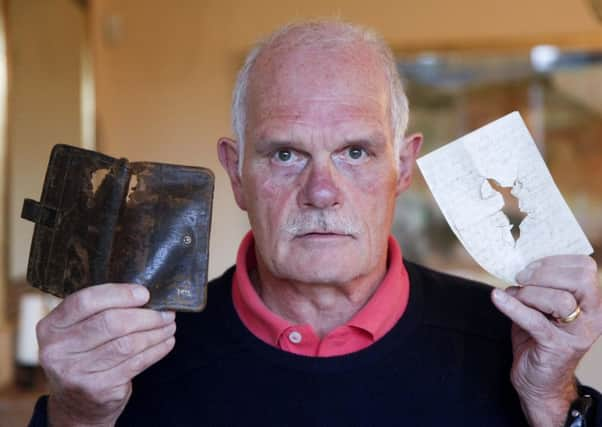'˜Here is hole in wallet from bullet which killed my Leith grandad'


But to one Edinburgh family that small tear marks an everlasting reminder of how their world was turned upside down almost exactly 100 years ago.
The wallet, and the poignant letters from his family back in Leith, were in the breast pocket of Private William Millar on the day he was shot dead by German soldiers.
Advertisement
Hide AdAdvertisement
Hide AdThe wallet – complete with a hole going straight through it from the bullet which killed him – were among the personal effects handed back to his grieving widow and passed down reverentially through the years to generations of his family..
Inside the wallet were a number of letters which the father-of-four had received from his loving wife back in Leith. They too were pierced by the same bullet.
For grandson Keith Millar, they are a very visible reminder of what his grandad and millions of others sacrificed for what we have today.
The 66-year-old said: “I inherited them from another family member and it still hits me when I see it. I don’t think that will ever change.
“When you open up the wallet all the letters are folded up. The bullet hole is pretty big and then there are serrated edges. You can just about make out what is written but you have to try and piece together the sentences where the bullet hole is.
“People back home didn’t know what was happening a lot of the time and my granny was talking about life back in Edinburgh.
“It is so striking to think that the bullet that went through that wallet was the one which killed my grandad.
“I was thinking of possibly donating it to the museum at Edinburgh Castle so it’s not just sat in a drawer in my home and others can see it for themselves.”
Advertisement
Hide AdAdvertisement
Hide AdPrivate Millar lived on Dixon Street before it is believed he was conscripted into the army and was part of the machine gun corps who served in France and Belgium.
He fought in the Battle of Messines Ridge which took place on June 7, 1917 when the British Second Army, led by Herbert Plumer, were victorious over the Germans in northern France.
It marked the successful prelude to an Allied offensive designed to break the grinding stalemate on the Western Front in the First World War.
British forces had put a lot of planning into the Battle of Messines Ridge. For the previous 18 months, soldiers had worked to place nearly £1 million worth of explosives in tunnels under the German positions.
The tunnels extended to some 2,000 feet in length, and some were as much as 100 feet below the surface of the ridge, where the Germans had long since been entrenched.
At 3:10am on June 7, 1917, a series of simultaneous explosions rocked the area; the blast was heard as far away as London.
A German observer described the explosions: “Nineteen gigantic roses with carmine petals, or enormous mushrooms, rose up slowly and majestically out of the ground and then split into pieces with a mighty roar, sending up multi-coloured columns of flame mixed with a mass of earth and splinters high in the sky.”
German losses that day included more than 10,000 men who died instantly, along with some 7,000 prisoners – men who were too stunned and disoriented by the explosions to resist the infantry assault.
Advertisement
Hide AdAdvertisement
Hide AdMeanwhile the Allies lost 24,000 men; 3,538 killed and just over 20,000 wounded or missing. The Germans as a result were forced to retreat to the east, a sacrifice that marked the beginning of their gradual but continuous loss of territory on the Western Front.
It also secured the right flank of the British thrust towards the much-contested Ypres region, the eventual objective of the planned offensive. Over the next month and a half, British forces continued to push the Germans back toward the high ridge at Passchendaele, and it was at this point when Private Millar was shot dead on July 27 1917.
It was only four days before the launch of the British offensive known as the Battle of Passchendaele or the Third Battle of Ypres which ended up being one of the bloodiest battles of the First World War.
Keith, his brothers Kenneth and Brent and their respective wives and family travelled to Belgium last year to mark the centenary of his grandfather’s death by visiting his grave at Oosttaverne Wood Cemetery.
The cemetery contains 913 British burials, 133 Canadian, 43 Australian, 19 New Zealand, one French plus an unknown number of German graves. Behind the cemetery are two German bunkers. There are also 117 Second World War burials of British soldiers who fell during the withdrawal to Dunkirk.
He said: “It was an unbelievable experience to see my grandad’s grave. It was very touching and to see all of the headstones, many of which were for unknown soldiers.
“For us as a family to go to the grave 100 years to the day my grandad was shot dead from German soldiers was incredibly moving.
“We stood and had a minute silence and it was we were getting emotional. It is incredible to see the white graves for those who died and we’re all so pleased we got the chance to go on that special day.
“With the centenary of the end of the first world war coming up it is so important we honour those who sacrificed everything for their country.”